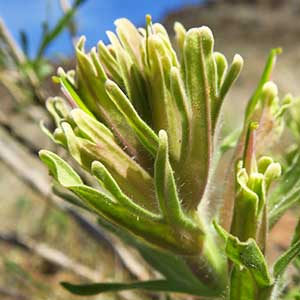Castilleja xanthotricha
Castilleja praeterita
John Day or yellow-hairy paintbrush, John Day paintbrush, yellow hair paintbrush, yellow-hair Indian paintbrush
Salmon Creek Indian paintbrush, Salmon Creek paintbrush
few to several, ± decumbent to erect or ascending, unbranched, sometimes with short, leafy axillary shoots, hairs erect to spreading, long, soft, eglandular, mixed with short stipitate-glandular ones.
several to many, ascending to erect, ± decumbent at base, branched or unbranched, sometimes with short, leafy axillary shoots, hairs spreading to ascending, long, soft to ± stiff, mixed with short-eglandular ones.
green, linear, lanceolate to broadly lanceolate, oblong, or cuneate, 0.8–5 cm, not fleshy, margins plane to wavy, involute, 0–5-lobed, apex acute, sometimes rounded;
lobes spreading, linear, arising below mid length, nearly as broad as center lobe, apex acute.
purple or green, linear-lanceolate to lanceolate, 3–5 cm, not fleshy, margins plane, partly involute, 3–5-lobed, apex acuminate, acute, or rounded;
lobes sometimes divergent, spreading-ascending, linear, apex obtuse to rounded.
3–14 × 1.5–4.5 cm;
bracts proximally greenish, rarely dull reddish purple, distally white to cream, rarely pale yellow or dull, pale pink (sharply differentiated from proximal coloration), lanceolate or oblong to narrowly ovate, (3–)5–7-lobed;
lobes ascending, linear to obovate, ± broadened distally, medium, long, proximal lobes arising below mid length, central lobe apex broadly rounded to truncate, others acute to rounded.
(2.5–)5–15 × 1.5–2 cm;
bracts proximally green to dull purplish, distally pale reddish purple, dull red, pale salmon, pale orange, or bright to pale yellow, oblong, 3(–5)-lobed;
lobes spreading to ascending, linear to oblanceolate, distal pair, if present, short and toothlike, short to long, arising at or above mid length, center lobe apex rounded to truncate, lateral lobes obtuse to rounded.
curved, 17–23 mm;
tube 15–19 mm;
beak exserted, adaxially green, 5–8(–9) mm, puberulent, stipitate-glandular;
abaxial lip deep purple (color sometimes visible through calyx), green, pinkish, or pale yellow, ± prominent, slightly inflated, usually hidden in calyx, sometimes right at top of calyx, 2 mm, ca. 50% as long as beak;
teeth ascending, whitish, yellowish, pink, or green, 1–1.5 mm.
straight, 11–16 mm;
tube 10–13 mm;
beak included or tip exserted;
beak adaxially green, 4–5 mm;
abaxial lip deep green, reduced, with narrow pouches, 2.5–3 mm, 30–45% as long as beak;
teeth reduced to minute apiculations, dark green, 0.5–1 mm.
colored as bracts, 15–26 mm;
abaxial and adaxial clefts 3.5–7 mm, 25–50% of calyx length, deeper than laterals, lateral 2–5 mm, 12–25% of calyx length;
lobes linear, oblong, or narrowly triangular, center lobe apex usually rounded, lobes acute to rounded.
proximally usually whitish, distally colored as bracts, 13–18 mm;
abaxial and adaxial clefts 5–6(–9) mm, ca. 50% of calyx length, deeper than laterals, lateral 0.5–1.2 mm, ca. 18% of calyx length;
lobes ± hemispheric, segments often curved outwards, exposing corollas, apex rounded to obtuse, rarely acute.
= 48.
= 24.
Castilleja xanthotricha
Castilleja praeterita
Castilleja xanthotricha is endemic to moderate elevations in the sagebrush hills of the John Day River drainage in north-central Oregon. N. H. Holmgren (1971) hypothesized that this tetraploid species is of allopolyploid hybrid origin between C. glandulifera and C. oresbia.
(Discussion copyrighted by Flora of North America; reprinted with permission.)
Castilleja praeterita is endemic to subalpine, sagebrush-dominated meadows in the southeastern Sierra Nevada of Inyo and Tulare counties. It is closely associated with and likely parasitic on Artemisia rothrockii. Inflorescence coloration varies by population, with some having only yellow-bracted plants, while others are pale orange to pale red with occasional pale yellow variants. Yet other populations have only pale salmon-colored bracts.
(Discussion copyrighted by Flora of North America; reprinted with permission.)
